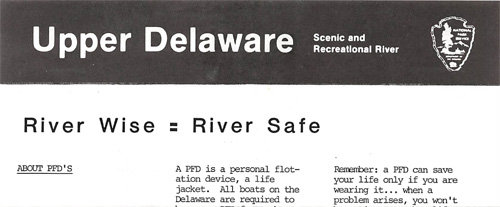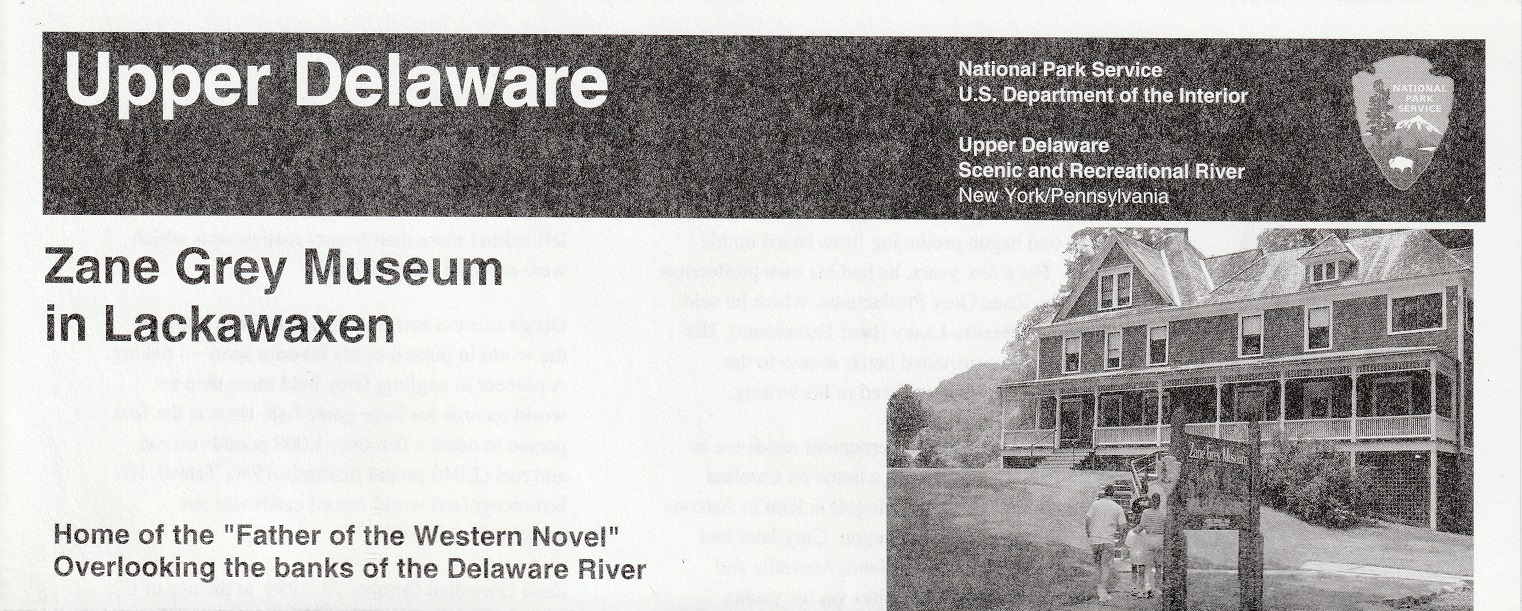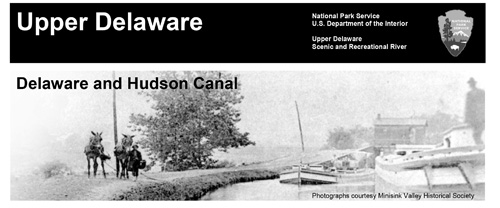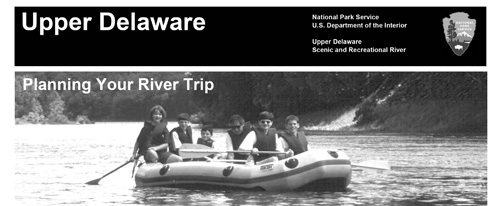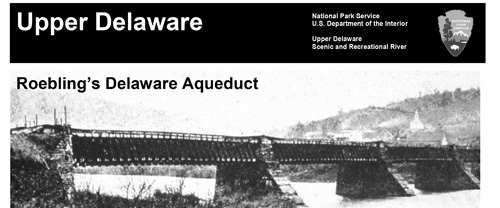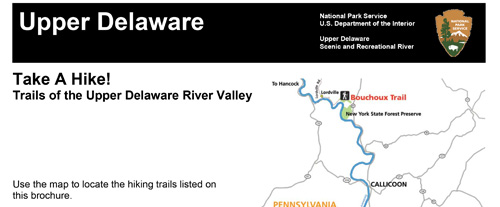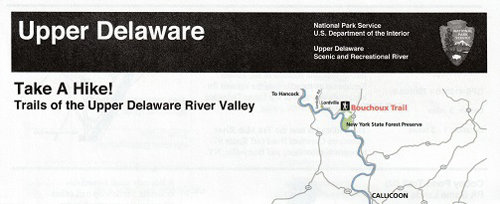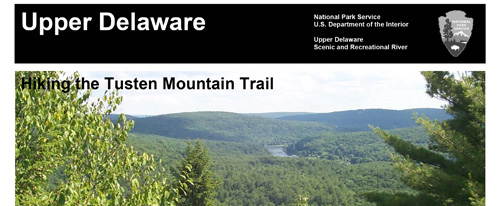|
Upper Delaware National Scenic & Recreational River New York-Pennsylvania |
 |
 NPS photo | |
As a part of the National Wild and Scenic Rivers System, Upper Delaware Scenic and Recreational River stretches 73.4 miles along the New York-Pennsylvania border. The longest and one of the cleanest free-flowing (undammed) rivers in the eastern United States, the Upper Delaware features riffles and Class I and II rapids interspersed with pools and eddies.
While most of the land along the river is privately owned, there is ample opportunity for canoeing, kayaking, rafting, tubing, fishing, and eagle watching. Villages, historic buildings, remnants of a once-busy canal, the nation's oldest existing wire cable suspension bridge. and the home of author Zane Grey are some of the river valley's sights.
National Park Service rangers provide information and enforce applicable regulations on the river. Local communities provide services. Upper Delaware Scenic and Recreational River is a partnership of individuals; private landowners; and local, state, and federal governments working to protect the river; its environment, and the communities in the valley.
On the River
Boating Whether by canoe, kayak, raft, or tube, the best way to see and get to know the Upper Delaware is to be on the river. The boating season usually runs from April to October. Most of the Upper Delaware River is a Class I stream in terms of difficulty, which means "moving water with a few riffles and small waves; few or no obstructions." One of the more difficult spots along the river is Skinners Falls. You should scout these rapids from shore before attempting passage. The most important thing to remember about boating is to always wear a PFD (personal flotation device, or life jacket). If you plan to camp overnight, make reservations at an established campground. Many private liveries along the river have campsites. Liveries rent kayaks, canoes, rafts, and tubes; provide safety instruction, gear and PFDs; and even shuttle you back to your vehicle. Almost all land along the river is privately owned, and trespass laws are enforced by local authorities. A valid registration is required for all motorized vessels.
Swimming/Wading Most drownings on the Delaware River have been swimming-related. The river has swift currents and sudden drop-offs. The Delaware's bottom can be rocky or muddy, shallow or deep. Rocks may be slippery. Wear a PFD and appropriate footgear, such as sneakers, while swimming, wading, or floating. There are no life-guarded beaches. Never swim alone.
Fishing The Upper Delaware is a popular stream for both casual and serious anglers. Brown and rainbow trout, smallmouth bass, walleye, white suckers, fallfish, and American eels are abundant. The American shad spawn here in late spring. A New York or Pennsylvania fishing license is required. Fishing guides are available for hire.
Eel Weirs Constructed by permit in late summer, V-shaped stone eel weirs with wooden racks are used to trap migrating American eels. Eels are born in the Sargasso Sea, far out in the Atlantic. After their first year, they head for rivers that flow into the ocean. Males remain at the mouth of the river, while females swim upstream to mature.
After about seven years the females return to the ocean, where they spawn and die. During this downstream migration in late summer and fall, the weirs come into play. They are made of two stone walls that form a downstream vee. At the point of the vee is a wooden trap that catches the eels, and they remain there until removed by the owner of the weir.
Bald Eagles Clean water, ample food, and stands of tall trees along the river make the Upper Delaware an ideal habitat for the bald eagle. The Upper Delaware watershed hosts the largest population of wintering bald eagles in the northeast, and a growing year-round population of eagles has made the area an ideal location for eagle watching.
Wildlife The river and its banks are feeding grounds for many animals. Muskrat, mink, raccoon, beaver, and snapping turtle are the most common. Be especially alert for raccoons, who like to scavenge food from unwary travelers. At dawn and dusk, watch carefully for white-tailed deer crossing the roadways. Be wary of skunks and porcupines—an encounter with either one can make you wish you had stayed at home.
A variety of snakes is found in the river valley—all but the timber rattlesnake and copperhead are nonvenomous. A special treat is seeing one of the region's black bears. Enjoy them from a safe distance. Avoid ticks, which can transmit Lyme disease, and mosquitoes, carriers of West Nile virus.
Roebling's Delaware Aqueduct
The oldest existing wire cable suspension bridge in the nation, the Delaware Aqueduct was built in 1848 as one of the major improvements on the Delaware and Hudson Canal (1828-98). The D&H was built to transport anthracite (hard coal) mined in northeastern Pennsylvania to markets in New York and New England. Gravity railroads took the coal over Moosic Mountain from Carbondale to Honesdale, Pa. From there the 108-mile canal carried the coal by boat through 108 locks to Kingston, N.Y., on the Hudson River.
The D&H hired John A. Roebling to build four suspension aqueducts on the canal. Two of these alleviated a major bottleneck on the Delaware River at Lackawaxen, Pa. Transporting boats above the river reduced the time required to cross the Delaware, making the D&H more competitive with its rivals—the railroads and other canals. Competition from railroads closed the D&H in 1898.
The Delaware Aqueduct was used for another 70 years as a private toll bridge. In 1980 it was sold to the National Park Service, which repaired and restored the masonry, reconstructed the roadway and deck, and replaced the wooden trunk walls and towpaths. The Towpath Trail follows the route of the earlier 1828-48 towpath. You may visit this site in Lackawaxen to learn more about the canal and John John A. Roebling Roebling's aqueduct.
The Zane Grey Museum
The one-time home of Zane Grey, novelist of the American West, is located on the banks of the Upper Delaware River in Lackawaxen, Pennsylvania.
As a young, aspiring writer, Grey left a dental practice in New York City and moved to Lackawaxen in 1905. He married the same year and, encouraged by his wife, devoted all his time to writing. He struggled through lean years until achieving success and fame with the publication of Riders of the Purple Sage in 1912, one of the most widely sold novels about the American West.
In 1914 Grey bought his brother Romer's home in Lackawaxen. Twice in four years Grey built additions to the house to provide private space away from his family, where he could do his research and writing.
Grey and his family moved to California in 1918. His popularity grew, and his influence expanded into the western movie industry. He became the most successful novelist of his time and is considered by some to be the father of the western novel.
Grey enjoyed the outdoors and was world-renowned for his fishing skills. He held several saltwater fishing records.
Exploring Upper Delaware
 (click for larger map) |
Getting to the Park You can reach this unit of the National Wild and Scenic Rivers System on highways from the New York and Philadelphia metropolitan areas. For the southern portion of the Upper Delaware River the standard routes are N.Y. 17, I-84, or U.S. 6. For the northern portion, the standard routes are N.Y. 17 and I-81. To follow the New York shore of the river use N.Y. 97.
Facilities and Accommodations Most towns along the river are small, with limited services. Port Jervis, Honesdale, Milford, and Monticello are the major centers with the most services. For information contact local chambers of commerce or other organizations. For a list of addresses, write to the park or check its website: www.nps.gov/upde.
General Information
River Safety Always wear a properly fitted, U. S. Coast Guard-approved PFD (personal flotation device, or life jacket) while boating, swimming, wading, or tubing on the river. A PFD is useless unless you wear it. By law, all children 12 and under must wear a PFD while on the river in any vessel, including inner tubes. A PFD is required for each person in a vessel, and must be accessible—not tied to the boat.
Guard against hypothermia by wearing protective clothing when the water is cold. Even in late spring when the air temperature is warm, the water is still frigid. Loss of body heat is 25 times greater in cold water than in air of the same temperature. Wear a wetsuit or clothing made of wool or polypropylene. If you go on the river, you should know how to swim. Never canoe alone. A minimum of two canoes is recommended, with one as lead canoe and another as sweep or drag canoe. Stay in view but keep a safe distance between canoes. If you capsize, keep upstream from the craft. A current of 3 mph can hold a swamped canoe against a rock with a force of more than a ton—the same effect as squeezing a canoe or paddler in a vise. If conditions worsen and you must leave your canoe, float with your feet pointed downstream and near the surface, to cushion yourself against large rocks and to prevent a foot or leg from getting caught on submerged branches or caught between rocks.
Carry a throw line and first aid kit with you. Do not drink alcoholic beverages before or during boating. Alcohol consumption and drug abuse have contributed to many drownings. Tie a plastic bag into the boat, and carry out your trash. Guard against sunburn with sunscreen and appropriate clothing. In summer, look out for poison ivy, ticks, and mosquitoes. Always check yourself for deer ticks if you've been in or near grassy areas.
River Conditions Information Before starting on your river trip, find out what to expect by calling the River Conditions Information Line. This recording is updated daily (in season) with reports of temperatures, river height, and safety conditions. Links to local weather conditions are available at www.nps.gov/upde/climate.html.
Traveler's Information Motorists traveling on N.Y. 97 near Sparrowbush, N.Y., or Hancock, N.Y., can get information about the Upper Delaware by tuning to AM 1610.
Outfitters Many privately owned liveries rent canoes, rafts, kayaks, tubes, and other craft. Licensed fishing guides are available.
Campgrounds All campgrounds along the Upper Delaware are privately owned, except for a Pennsylvania State Forest primitive camping area near Stairway Rapids. Permits for this camping area are available from the National Park Service, Barryville Office.
Source: NPS Brochure (2006)
|
Establishment Upper Delaware River Scenic & Recreational River — November 10, 1978 |
For More Information Please Visit The  OFFICIAL NPS WEBSITE |
Brochures ◆ Site Bulletins ◆ Trading Cards

Documents
A Research Plan to Study Appropriate River Recreation Use on the Delaware Water Gap National Recreation Area, New River Gorge National River and Upper Delaware Scenic and Recreational River Mid-Atlantic Region Research/Resources Management Report(David W. Lime, Dorothy H. Anderson, Richard C. Knopf, John H. Schomaker and Richard Schreyer, July 1985)
An Analysis of Community Response to Federal Presence in the Upper Delaware River Valley: A Report to Managers Mid-Atlantic Region Research/Resources Management ReportMAR-24 (Matthew S. Carroll, Ben W. Twight and Marsha McCabe, June 1987)
Analysis of Legislative and Legal Foundations for Establishing Carrying Capacity: Summary Report for the Upper Delaware Scenic and Recreational River Mid-Atlantic Region Research/Resources Management ReportMAR-37 (Steve Simpson and Leo McAvoy, October 1987)
Assessment of Natural Resources and Watershed Conditions for Delaware Water Gap National Recreation Area and Upper Delaware Scenic and Recreational River NPS Natural Resource Report NPS/NER/NRR-2011/429 (Carolyn G. Mahan, Bruce J. Miller, Michael C. Saunders and John A. Young, July 2011)
Cultural Landscape Inventory: Zane Grey House, Lackawaxen, PA (Jeremy Foster, September 26, 1994)
Cultural Landscapes Inventory: Roebling Bridge, Upper Delaware Scenic and Recreational River (2003)
Delaware and Hudson Canal: Past and Present (Diann L. Jacox, December 1979)
Ecological Impacts on Recreation Sites at Upper Delaware Scenic and Recreational River, Pennsylvania-New York Mid-Atlantic Region Research/Resources Management ReportMAR-28 (Jeffrey L. Marion and David N. Cole, September 1987)
EIS Upper Delaware Scenic and Recreational River Draft (1986)
Foundation Document, Upper Delaware Scenic and Recreational River, New York, Pennsylvania (February 2014)
Foundation Document Overview, Upper Delaware Scenic and Recreational River, New York, Pennsylvania (February 2014)
Historic Furnishings Report: Zane Grey House (Historical Data with Implementation Options) (Laurel A. Racine, May 2003)
Historic Structure Report, Historical Data Section: The Delaware Aqueduct, Upper Delaware National Scenic and Recreational River, New York-Pennsylvania (Harlan D. Unrau, September 1983)
Identification and Preliminary Analysis of River Recreation Impacts on Fish and Wildlife: Upper Delaware Scenic and Recreational River Mid-Atlantic Region Research/Resources Management Report(Michael Patterson, Joseph W. Roggenbuck and James D. Fraser, November 1988)
Interagency Resource Impacts Directory, Upper Delaware Scenic and Recreational River (Malcolm Ross, Jr. and Ruth M. Hartmann, September 1989)
Junior Ranger River Safety Activity Book, Delaware River (Date Unknown)
Management of River Resources at Delaware Water Gap National Recreation Area and Upper Delaware Scenic and Recreational River — A Survey of Visitor Opinion Mid-Atlantic Region Research/Resources Management ReportMAR-33 (Richard C. Knopf, Alan R. Graefe and Richard Schreyer, August 1988)
Park Newspaper: 1985
Proposed River Management Plan: Upper Delaware National Scenic and Recreational River, New York and Pennsylvania (October 1983)
Roebling's Delaware & Hudson Canal Aqueducts Smithsonian Studies in History and Technology No. 10 (Robert M. Vogel, 1971)
Soil Survey of Upper Delaware National Scenic and Recreational River, New York and Pennsylvania (2013)
Summary of Research Objectives, Accomplishments, and Future Needs for the Study of Appropriate River Recreation Use on the Delaware Water Gap National Recreation Area, New River Gorge National River and Upper Delaware Scenic and Recreational River Mid-Atlantic Region Research/Resources Management Report(David W. Lime, January 18, 1989)
The Aginners and Others: A Case Study of Citizen Protest On the Upper Delaware Scenic and Recreational River (Mary E. Curtis, 1988)
Upper Delaware Scenic and Recreational River
Books

upde/index.htm
Last Updated: 26-Dec-2023




